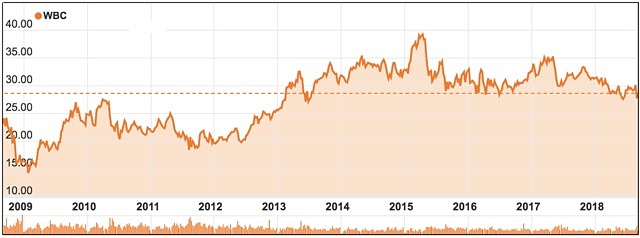Westpac left to justify out-of-cycle interest rate hike as other banks may follow suit

Westpac is the first of the big four banks to raise its home loan rates.
A decision this week by Westpac Banking Corporation (ASX: WBC) to raise its variable home loan interest rate by 14 basis points in an effort to recoup an increase in its borrowing costs has raised hackles in all corners of the market, with experts suggesting the floodgates have been opened for other banks to follow suit.
The interest hike, effective from 19 September, will raise the standard variable rate for the bank’s principal and interest borrowers from 5.24% to 5.38% and add approximately $30 per month to the average $300,000 home loan.
Standard variable owner-occupiers with interest-only repayments to Westpac will see their rates increase to 5.97%.
Over a 25-year-loan, the move will add about $25,000 to a customer’s total loan costs.
Customers of Bank of Melbourne, BankSA, St George Bank and RAMS – all owned by Westpac – will also be affected, with these banks matching the rates activity of their parent company.
And while most households will be able to absorb increases, anyone who overstretched to get into the market will likely feel the sting.
Westpac claims the interest rate increase is a “necessary part of ensuring the long-term sustainability” of its business in light of higher wholesale funding costs from international markets, which has the potential to add $400 million per year to its cost base.
The bank said its net interest margin – the difference between what it charges borrowers and what it pays for funding, and a key indicator of profitability – was down 11 basis points to 2.06% in the third quarter, and below the expected 2.13%.
As if to refute this claim, the Reserve Bank of Australia said in the minutes of its August meeting held before Westpac’s announcement, “funding costs have risen a little in 2018 as a result of the increase in short term money market rates but have remained low relative to history”.
A difficult pill to swallow
Westpac has drawn little more than criticism in the days following its interest rates decision and it’s not difficult to see why.
Banking majors are veritable cash cows as demonstrated in the first half of 2018, with Australia’s top four – Westpac, ANZ, Commonwealth Bank and National Australia Bank, which collectively own 80% of the market – reporting a combined cash profit of $15.2 billion to 30 June, down just 2% on the previous corresponding period.
Westpac’s contribution to that figure was a whopping $4.2 billion, which makes an out-of-cycle rate hike a fairly difficult pill for the average homeowner to swallow.
It also raises the question as to why the bank couldn’t direct some of its win towards resolving its own funding cost dilemma.
Then there’s the Reserve Bank of Australia’s official cash rate, which has remained steady at 1.5% for a record 24 months and is not expected to move before 2020.
The prospect of long-term rate stability has fostered a mixture of relief and panic at consumer level, with finance experts long predicting that one of the country’s four major banks would break the interest rate dry spell and announce an out-of-cycle hike.
On Wednesday, Westpac became that bank.
Demanding answers
When the interest rates announcement went public, Australian prime minister Scott Morrison was among the first to demand answers.
“[Westpac] have to justify, in this environment when people are really feeling it, why they believe they need to clip that ticket a little harder when people in Australia and their customers I think are doing it tough,” he said.
Mr Morrison encouraged unhappy customers to vote with their feet, saying competition is important to a strong and accountable banking system.
“If you don’t like what Westpac’s done, go to another bank,” he said, somewhat failing to take into account the considerable costs incurred by the average consumer in changing lenders such as mortgage discharge and early termination fees, break costs on fixed rate loans, new application fees and stamp duties.
“My view is it’s up to the bank to explain to the Australian people why it lifted rates,” said deputy Liberal leader and federal treasurer Josh Frydenberg, who was also on the bank’s tail.
“Any financial institutional which makes these decisions needs to explain to its customers why.”
Positive reactions
Fund managers were among the only parties to welcome Westpac’s announcement, believing that the interest rate rise “had to happen” especially after the bank’s net margin disappointed investors earlier this month.
“United States funding costs have been rising and between 50% to 70% of the sector’s wholesale funding comes from offshore,” said one asset fund manager.
“Even the RBA staying on hold at 1.5% for two years hasn’t eased the pain of this year’s higher funding costs.”
It’s now just a matter of time to see if the remaining three big banks will follow Westpac’s lead, however USB analyst Jonathan Mott believes they will be in no great rush.
“While the banks generally follow each other in out-of-cycle repricing, we would not be surprised to see the other banks hold off for a few weeks or months as they are not facing the same net interest margin pressures as Westpac,” he said.
Mr Mott said ongoing focus on banking industry conduct by the Australian Competition and Consumer Commission may become another deterrent to knee-jerk reactions in the sector.
Last year, the competition watchdog was granted an extra $13.2 million over four years in the Turnbull government’s budget to fund a new unit to crack down on conduct and behaviours by the big four banks, including unexplained rate hikes for home buyers.

